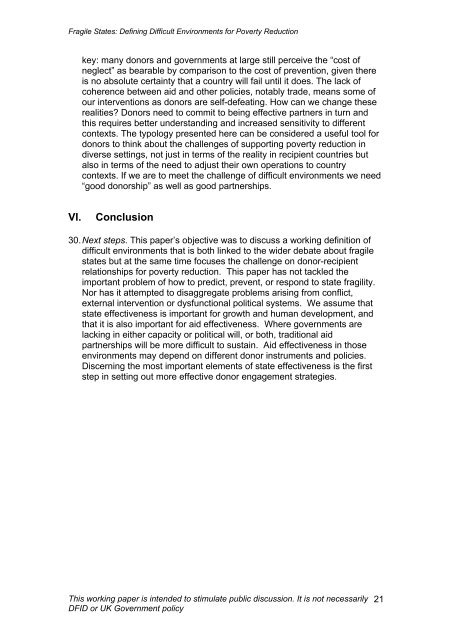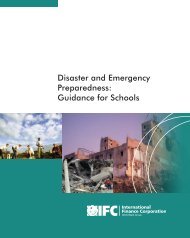Fragile States: Defining Difficult Environments for Poverty ... - INEE
Fragile States: Defining Difficult Environments for Poverty ... - INEE
Fragile States: Defining Difficult Environments for Poverty ... - INEE
Create successful ePaper yourself
Turn your PDF publications into a flip-book with our unique Google optimized e-Paper software.
<strong>Fragile</strong> <strong>States</strong>: <strong>Defining</strong> <strong>Difficult</strong> <strong>Environments</strong> <strong>for</strong> <strong>Poverty</strong> Reductionkey: many donors and governments at large still perceive the “cost ofneglect” as bearable by comparison to the cost of prevention, given thereis no absolute certainty that a country will fail until it does. The lack ofcoherence between aid and other policies, notably trade, means some ofour interventions as donors are self-defeating. How can we change theserealities? Donors need to commit to being effective partners in turn andthis requires better understanding and increased sensitivity to differentcontexts. The typology presented here can be considered a useful tool <strong>for</strong>donors to think about the challenges of supporting poverty reduction indiverse settings, not just in terms of the reality in recipient countries butalso in terms of the need to adjust their own operations to countrycontexts. If we are to meet the challenge of difficult environments we need“good donorship” as well as good partnerships.VI.Conclusion30. Next steps. This paper’s objective was to discuss a working definition ofdifficult environments that is both linked to the wider debate about fragilestates but at the same time focuses the challenge on donor-recipientrelationships <strong>for</strong> poverty reduction. This paper has not tackled theimportant problem of how to predict, prevent, or respond to state fragility.Nor has it attempted to disaggregate problems arising from conflict,external intervention or dysfunctional political systems. We assume thatstate effectiveness is important <strong>for</strong> growth and human development, andthat it is also important <strong>for</strong> aid effectiveness. Where governments arelacking in either capacity or political will, or both, traditional aidpartnerships will be more difficult to sustain. Aid effectiveness in thoseenvironments may depend on different donor instruments and policies.Discerning the most important elements of state effectiveness is the firststep in setting out more effective donor engagement strategies.This working paper is intended to stimulate public discussion. It is not necessarilyDFID or UK Government policy21
















